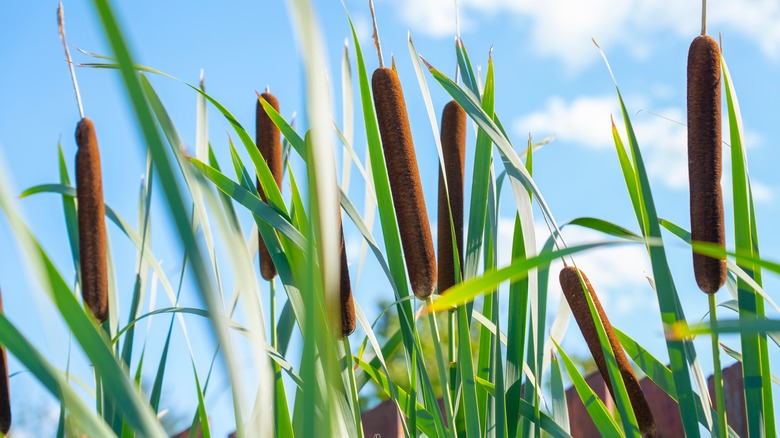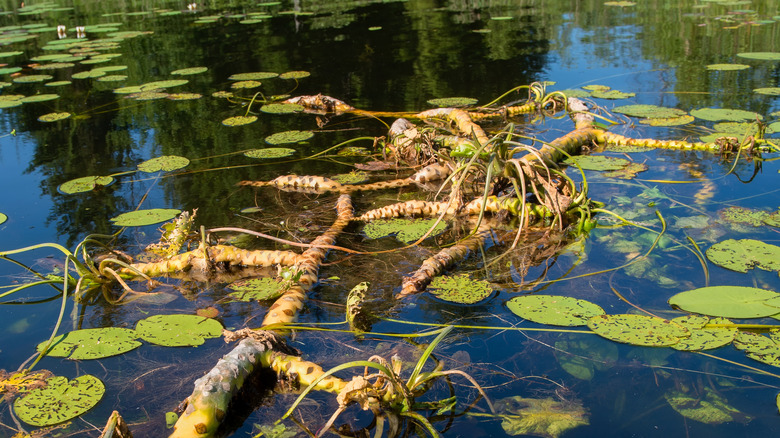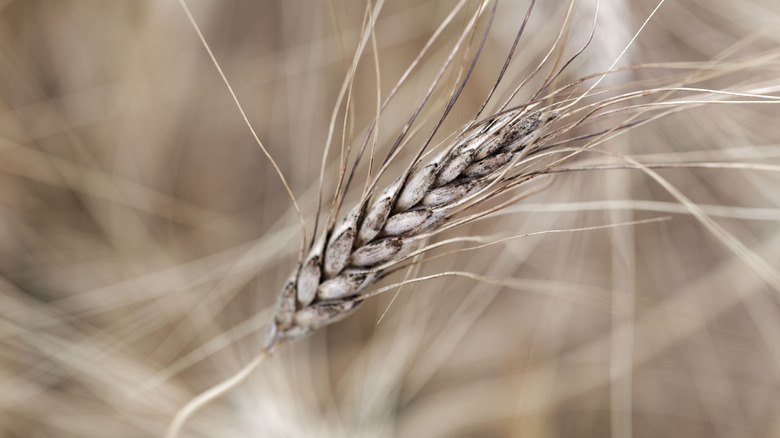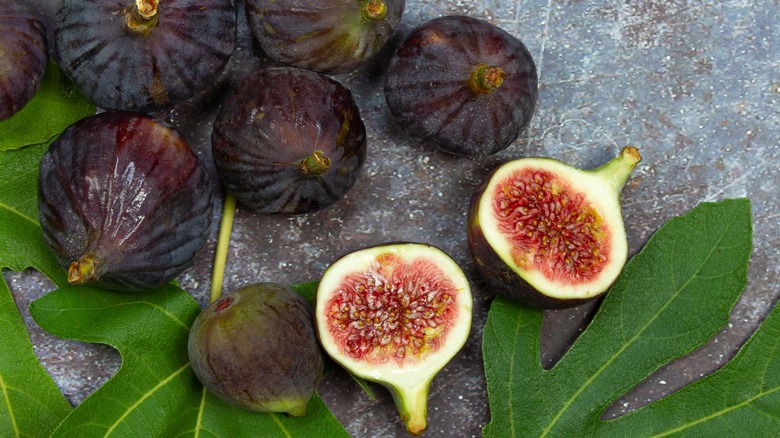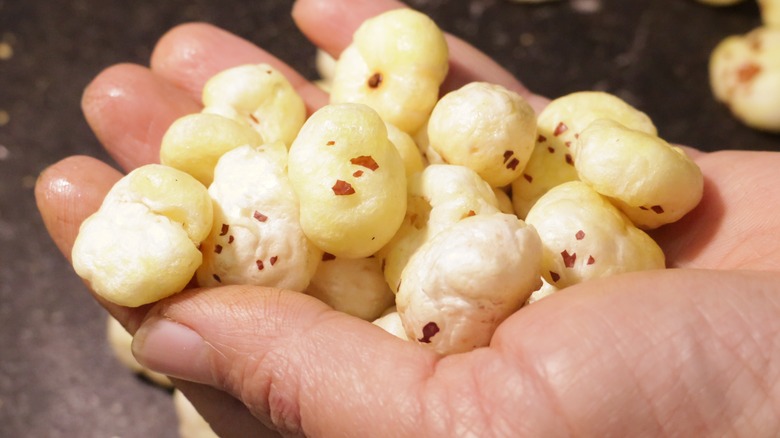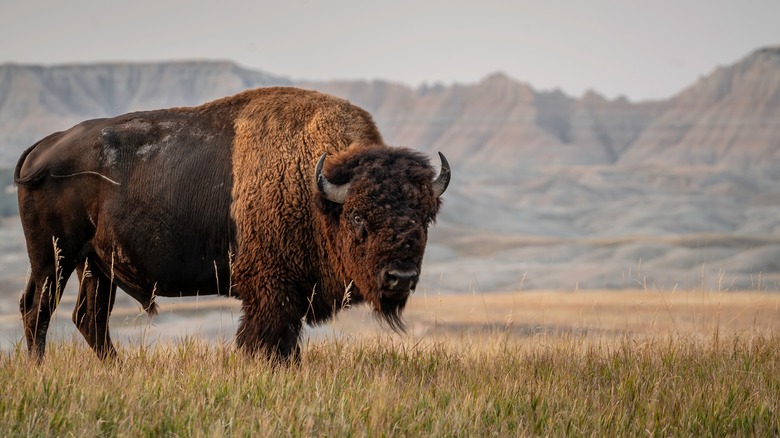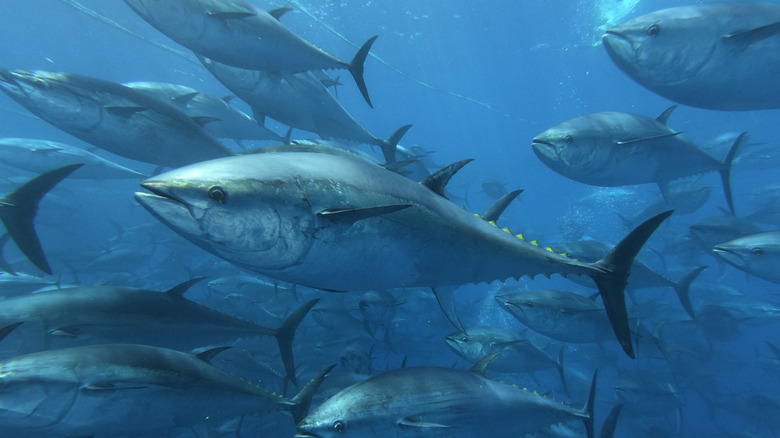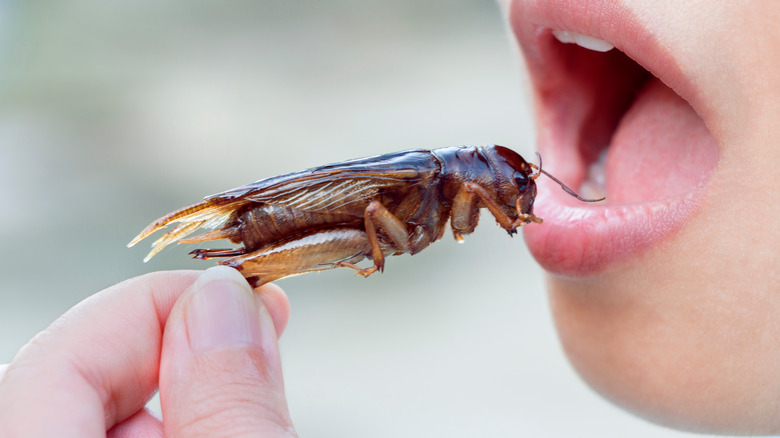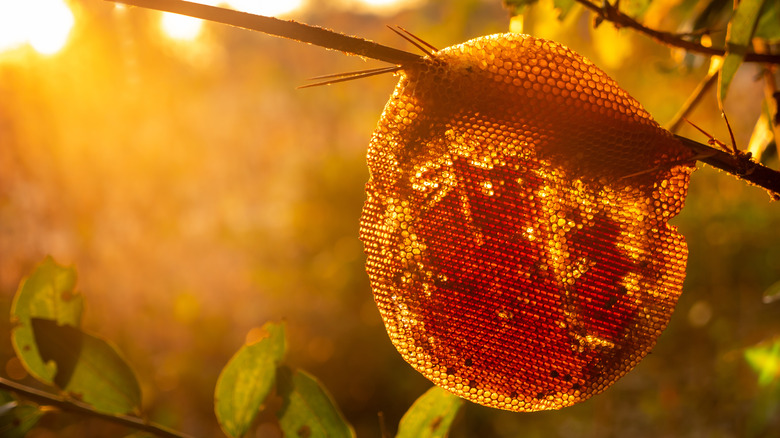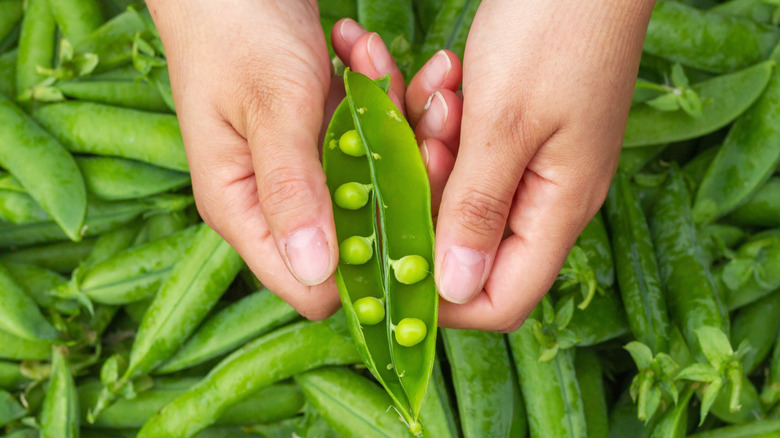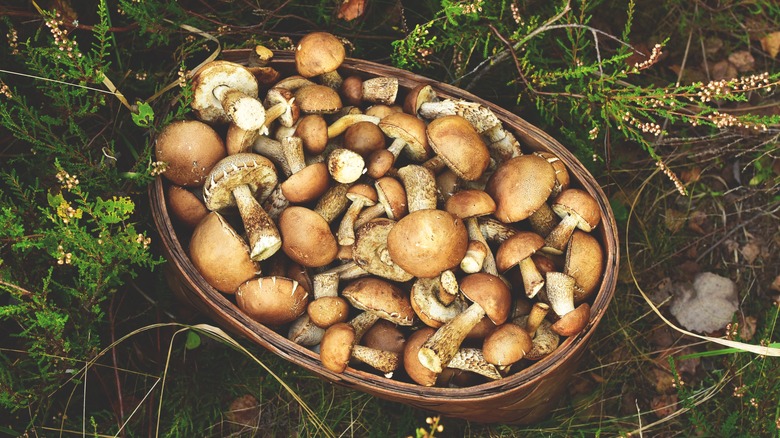What Did Cavemen Really Eat During The Paleolithic Period?
Cavemen from the Paleolithic era between 2.5 million years ago to 10,000 B.C. were eating quite a lot of things (via History). In his article from Business Insider, Peter S. Ungar, a paleoanthropologist from the University of Arkansas, says that the trendy paleo diet people eat today is based on a myth. Asking what our ancestors ate during the Paleolithic era makes no sense because it depended on food availability. There's no one specific diet we can point to as the ideal paleo diet. When we reached out to Ungar, he said that humans are "versatile dietary generalists that can often find something to eat just about anywhere. What our ancestors ate depended on what was available where and when they lived. And that changed over time with climate and local habitat." He further told us, "There is no fixed meat-to-plant ratio in the diet at any given time." So you can't generalize by saying that cavemen ate mainly meat or mainly plants or that they all ate one specific diet.
To determine what foods the various people of the Paleolithic period were eating, it's necessary to look at what remains behind on their teeth and tools. Some scientists had previously proposed that the Neanderthals died out because their diet was overly reliant on meat, making them nutritionally deficient. However, more recent research into what was left behind of Paleolithic Neanderthal teeth tells a different story. A 2014 study shows that, in addition to meat, both Homo sapiens and Neanderthals were eating a wide variety of plants, including foods ranked high and low for energy and nutritional value.
Plants
People during the Old Stone Age would have encountered much smaller vegetables than the ones we eat today. According to National Geographic, many plants evolved tasty fruits to entice animals to eat and disperse their seeds. However, vegetables didn't have the need for wide dispersion, so they didn't evolve sweet outer portions to tempt animals like fruits did (via Slate). According to National Geographic, it wasn't until the next archeological period, the Neolithic period, that people began cultivating vegetables to be larger and more palatable. During the Paleolithic period, tomatoes, potatoes, and carrots were minuscule; corn was hard; peas required peeling and roasting, cucumbers and lettuce were prickly, and sea kale (the closest thing to cabbage) was tough and bitter.
Necessity led the way to people of the Early Stone age eating plants we often don't think of when creating a meal. For example, a study published in the Journal of Human Evolution says that some were eating grass leaves, tender fern shoots, and cattails. In spring, they could eat cattail stalks and shoots or consume cattail catkins like corn-on-the-cob (via Farmers' Almanac). According to Scientific American, Some caveman species like Paranthropus boisei were eating a diet that contained at least three-quarters grasses and sedges (a grasslike flowering plant). A PNAS article explains that it's possible that cavemen may have been eating the edible underground nutrition storage components of sedges called corms.
Flowers
When we talk about people eating flowers, it's not always just the flowering part of the plant that is edible. Flowers, buds, pollen, stems, leaves, and rhizomes of some flowers are also edible. According to a 2000 study, the molars of the earliest hominins would have been too flat to chew tougher types of plants easily. So, many hominins who lived prior to the Paleolithic period would have had to eat much softer plant matter, like tender shoots, buds, and flowers. Later species in the Paleolithic period had more highly-crested molars, which would have helped them consume more parts of a flower than just the soft buds and flowers.
A 2014 study of debris found in the teeth of hominins from the Paleolithic era revealed quite a lot of floral matter in their diets. Some of the flowers that cavemen were consuming included white water lilies (Nymphaea alba), yellow water lilies (Nuphar lutea), harlequin flowers (Sparaxis bulbifera), and South African cape bulb (Babiana cedarbergensis).
Water lily flowers, buds, and leaves can be eaten cooked or raw, while the root is usually boiled or roasted (via Edible Wild Food). It's also possible to pop water lily seeds like popcorn, and followers of a modern paleo diet can even buy popped water lily seeds as snacks. While there aren't really people eating harlequin flowers or South African cape bulb parts in the modern age, there are still plenty of flowers you can eat from your garden that cavemen were likely eating in the Paleolithic period.
Tubers
Hungry cavemen in the Paleolithic period wouldn't have stopped with the plant parts they could see above ground but would have dug into the ground looking for anything edible. Underground, they would have discovered the swollen food storage organs of the plants (collectively called geophytes). Underground food storage organs include tubers, rhizomes, bulbs, or corms (via The Spruce). Modern examples of tubers are potatoes, which the Incas didn't cultivate until after the Paleolithic period, in 8,000 to 5,000 B.C. (via Potato Goodness). Meanwhile, Paleolithic examples of tubers would be water lily roots (via Journal of Human Evolution). It's also possible that they would ground cattail roots into flour, which prehistoric archeologist Emanuela Cristiani says can be baked into a sweet bread (via Horizon).
Horizon says that the first evidence we have of cavemen cooking and eating tubers was 100,000 years ago in Africa during the Paleolithic period. These nutritious roots were an excellent source of starch and glucose, which were necessary for energy and building bigger brains.
In a Current Anthropology article, paleobiologist Amanda Henry mentions that some tubers are toxic when eaten raw. Thus, learning to harness fire would have allowed our Paleolithic ancestors access to cook and eat more nutritious underground tubers from plants. However, not all tubers require cooking for digestibility, and some are even less digestible when you eat them. Horizon quotes Henry as saying that cavemen may have been boiling tubers, often to make them easier to peel.
Grains
Both raw and cooked grains were a part of the Paleolithic caveman diet. As far back as 40,000 years ago, Neanderthals living in caves in Iraq and Belgium caves were eating grains related to modern-day wheat and barley. Hunter-gatherer groups living along the Danube River 10,000 years ago ate oats (via Horizon). A 2014 study of Neanderthal teeth revealed several specific grains Paleolithic cavemen ate. These include two grains in the barley family (Hordeum bulbosum and Secale vavilovii), two types of wheat (Triticum turgidum and Aegilops longissima), two grasses (Aegilops speltoides and Brachiaria dura), two sorghums (Sorghum bicolor and Sorghum halepense), and two types of millet (Setaria italica and Panicum miliaceum).
Horizon quotes prehistoric archeologist Emanuela Cristiani as saying that creating stone grain-grinding tools provided them a new way to eat grains. The earliest evidence we have for cavemen grinding grains into flour comes from 30,000 years ago in Russia, the Czech Republic, and Italy.
Fruit
A 2020 study indicates that fruit evolved in size, color, scent, and other traits to appeal to birds and animals that would eat them and disperse their seeds. A 2022 study says that our first evidence of birds spreading fruit seeds is from the Early Cretaceous era, around 120 million years ago. Sweet, tasty fruits were certainly just as enticing to Paleolithic cavemen as they were to early animals and birds (via National Geographic). Since fruit is portable, hominins would have continued seed dispersion when traveling from place to place, casting off a seed here and there as they ate pieces of fruit.
Some of the fruit residue scientists have found in hominin teeth came from date palms. Slate says researchers have discovered proof of edible apples in Kazakhstan from 30,000 years ago; figs, olives, plums, and pears in northern Israel from 780,000 years ago; oranges in China; and berries in Europe. Many of the fruits of the Paleolithic era were similar in form to the ones we eat today. However, modern fruit is often larger and sweeter, since humans have since cultivated them for more desirable traits (an innovation we wouldn't think to do until a later era).
Seeds and nuts
Smithsonian Magazine lists water chestnuts, almonds, and gorgon nuts among the nuts Paleolithic hominins were eating. New Scientist says Paleolithic cavemen were eating thistle seeds, which are a good source of oil and would have been a good source of starch if the cavemen roasted them. Water lilies also contained starchy seeds. A 2017 study says that oily seeds are easier to digest when they are cooked. While rare, a handful of Paleolithic archeological sites have contained charred seeds and nuts. The charred seeds may have been accidentally burned, so it's still not proof that cooked seeds were a common food.
People living in villages along the Danube River were eating acorns 10,000 years ago (via Horizon). Acorns are highly bitter, but they're edible once you've leached out all the tannins by boiling or soaking them in water. Then, they're ready to roast or grind into acorn flour (via Almanac).
Grass seeds were also a source of sustenance. A 2014 study shows that Paleolithic Neanderthals were eating Brachiaria dura seeds. The 2020 study says that finding rare gelatinized starches in tooth residue was proof that some paleo hominins were eating cooked grass seeds. However, this practice may not have been widespread.
Meat
Some researchers estimate that the true paleo diet was only about 3% animal products (via National Library of Medicine). We talked with Peter S. Ungar, an anthropologist from the University of Arkansas, about how much meat Paleolithic humans were eating. He said, "It is likely that the amount of meat eaten increased over time with the origin and evolution of the human genus, but the details are murky. We start to get tell-tale butchery marks bones found at hominin sites, the teeth may get a little sharper with Homo erectus, etc. We do have ancient DNA and isotope signature in more recent hominins suggesting at least some meat eating — but again, all this varies over time and space both within and between species."
Not only were Paleo cavemen moving away from eating all their meat raw, but increasingly better hunting tools allowed them better access to meat (via National Library of Medicine). Scientific American dates the earliest arrowhead to 71,000 years ago in South Africa. Atlatls made spear-throwing even easier when they were invented 17,000 years ago in Europe (via ThoughtCo).
A 2018 study indicated that Paleolithic Neanderthals were mainly eating medium and large adult animals. There is evidence of Paleo cavemen eating wolves, bears, and cats. Elephant brain was on the menu in Israel (via Persee). Dental residue in other studies shows paleo cavemen eating bison, animals in the horse family, Siberian ibexes, cave hyenas, foxes, and even Neanderthals. However, there is evidence that Neanderthals weren't just big game hunters. They incorporated small mammals, birds, fish, and seafood into their diets as well (via Plos One).
Fish and seafood
Fish and seafood are other opportunistic types of food. Populations living in coastal regions were more likely to depend on fish and seafood for a larger portion of their diets than other groups (via National Library of Medicine). Shellfish are a given since they're easy to collect in the shallows. On his blog, paleoanthropologist John Hawks mentions several Paleolithic archeological sites that have yielded shellfish remains. However, fish are a little trickier to catch. Still, archeologists found fish bones from an easy-to-catch inshore fish species in a South African cave that date back 140,000 to 50,000 years (via Nature). So, cavemen were consuming fish as soon as they figured out how to catch them.
According to Nature, the earliest fishing hooks date from 40,000 years ago in East Timor. Most of the fish were tuna, but others included sharks and rays. The Christian Science Monitor says that archeologists also uncovered 23,000-year-old sea-snail fishing hooks in a cave on Okinawa Island in Japan. Fish remains in the Okinawa cave showed signs of fire, which indicates that the humans there cooked their fish, along with other small animals.
Hakai Magazine says that Paleolithic stone sinkers from 29,000 years ago provide evidence of a net-fishing culture in Korea. These hooks would have helped hold ropes are nets underwater for catching fish. After Paleolithic hominins learned knitting and threading techniques, they could use nets to catch even more fish than a singular hook ever could. However, at least one scientist is dubious that these "stone sinkers" are more than ordinary rocks.
Insects
According to Discover Magazine determining whether cavemen ate insects during the Paleolithic period isn't as easy as some other types of foods. When you find a piece of an ancient insect shell next to a pile of animal bones from a caveman meal, it's difficult to know whether the insects were a part of the meal or died in the cave of natural causes. However, there are several compelling arguments for insects being a common protein source during the Paleolithic period. Insects are a lot easier to catch than wild animals, and pretty much all our evolutionary primate cousins eat beetles, termites, ants, bees, wasps, crickets, locusts, butterflies, and moths in various life stages.
A 2014 study shows that the same weight of insects can provide more calories (330-588) and nutrients than the same weight of fruit or leaves (50-370). You may not need to eat as many larger insects to have a satisfying meal, but you'd need a whole pile of smaller insects like ants to feel full. Researchers have found several clues that the non-hominin caveman Australopithecus robustus was eating termites and making termite-digging tools as far back as 4 million years ago, before the Paleolithic period (via Ask Entomologists). According to the United Nations, there are over 1,400 species of insects that humans from various cultures eat today, and they may become more common again in the future in countries that don't traditionally eat them.
Honey
According to Smithsonian Magazine, nutritional anthropologist Alyssa Crittenden says that rock art from as far back as 40,000 years ago on four continents depicts images of honey collection. As recently as 25,000 years ago, the art showed people using ladders to collect honey and smoking bees in hives. By the middle of the Paleolithic period, we think humans were using fire, so hive smoking could have started much earlier (via PNAS).
Crittenden says that another piece of evidence that early cavemen ate honey is that our primate cousins, like orangutans, gorillas, and chimpanzees, use sticks to collect honey from hives. Once cavemen started using stone tools, they would have been able to crack into beehives even more easily. Crittenden thinks that 2.5-million-year-old tools that researchers found in Ethiopia are perfect for splitting open beehives.
Crittenden also theorizes that having better tools to collect honey may have been the key to hominins being able to evolve larger brains than our predecessors and other cavemen rivals. Not only does honey contain glucose for brain development, but it also sometimes contains bee larvae, which add fat, protein, vitamins, and minerals to the diet. With honey being so energy-rich, we wouldn't have had to work so hard at collecting calories elsewhere.
Legumes
Legumes like beans and lentils aren't allowed on the trendy, modern paleo diet (via Healthline). However, the historical paleo diet definitely included legumes when cavemen could find them. Legumes are highly nutritious and full of protein, so they would have been an excellent alternative or accompaniment to meat in the real Paleolithic diet. Cholesterol-free legumes also would have provided fiber, carbohydrates, vitamins, and minerals to their diet (via Clinical Diabetes).
Dental plaque from Neanderthals provides us with evidence that Paleolithic cavemen were indeed eating legumes. Researchers have found proof of populations eating both peas (Pisum sativum) and chickpeas (Cicer arietinum) as a part of their diets. Marija Ljustina from the University of Belgrade says that peas were a part of the everyday diet for hunter-gatherers in Europe as the last Ice Age was ending. Interestingly, most European countries have their own word for "pea," which Ljustina says shows that the pea came before language diversification. Legumes were valuable enough to the caveman diet that chickpeas, lentils, peas, and bitter vetches were among the first plants that hominins cultivated to be bigger and better as the Paleolithic period slipped into the Neolithic period (via Frontiers in Plant Science).
Fungi
Fungi evolved on land much earlier than plants — around 1,300 million years ago (via Penn State University). So, hungry cavemen would have definitely been testing fungi for edibility long before the Paleolithic period. Yet, the first proof we have of the human diet containing mushrooms came from mushroom residue on teeth from 12,000 to 18,000 years ago. The proof comes from microremains of fungi spores on the teeth of the Red Lady of El Mirón cave in Cantabria, Spain. She was found in a cave decorated with sparkling red paint and yellow flowers. A 2015 study of dental plaque residue included plant pollen, fungi, and meat. Specifically, the fungi she had been eating were sponge-capped bolete mushrooms as well as a type of Agaric gilled mushroom (via Daily Mail).
Mushroom hunting has persisted and is still a part of Spanish culture. Thousands of people go to the countryside in the fall to hunt various mushrooms, including boletes (via Iberia Nature). In fact, the word Spaniards use to encompass all mushrooms is "bolet," which highlights the bolete's historical culinary importance from the time of early man onward.

